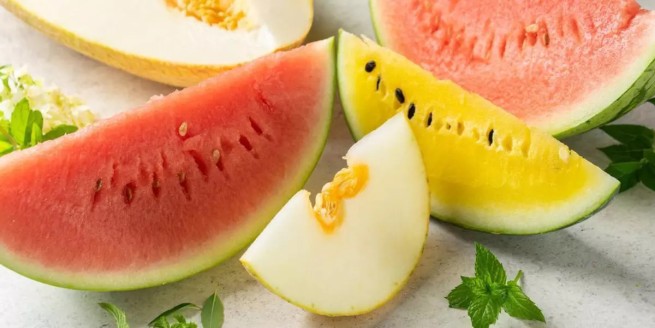Striped and yellow berries that everyone loves – watermelons and melons – have already appeared in stores and markets. Doctors confirm that they are not only tasty, but also healthy. So which one is better to give preference to?
Both products are naturally low in calories, fat and sodium (salt). On the contrary, they are rich in valuable nutrients. This is reported by experts at the Medical West Hospital of the University of Alabama at Birmingham.
According to the US Department of Agriculture (USDA) FoodData Central food database, 100 grams of watermelon contains:
- 91.4 grams of water
- 30 calories
- 7.5 gr. carbohydrates (mono- and disaccharides, fructose, etc.)
- 0.4 gr. cellulose
- 6.2 gr. glucose.
Accordingly, on 100 grams of melon provided (prices may vary slightly depending on the variety):
- 90.2 grams of water
- 34 calories
- 8.16 gr. carbohydrates (mono- and disaccharides, fructose, etc.)
- 0.9 g fiber
- 7.8 gr. glucose.
Vitamins and microelements
Melons and melons also contain various vitamins and microelements. These include vitamins A, C and B6, which boost immunity, vision and energy. They also contain potassium, which is essential for maintaining normal blood pressure and muscle function.
Each of them, of course, has its own unique nutritional value. Watermelon, for example, also contains lycopene. It is an antioxidant substance that reduces the risk of cancer and cardiovascular disease.
Melon It is especially rich in vitamin A, which gives it strong antioxidant properties. This vitamin is essential for healthy vision and skin.
Accordingly, melon is an excellent source of vitamin C, which improves immunity. Casaba melon contains vitamin C and potassium, while Crenshaw melon is rich in vitamin C, potassium, iron and calcium.
How to choose them
To select a good melon or watermelon, first make sure it is firm. They should not have soft spots, dents or irregularities. It is also important that the fruit has an aroma, a sweet smell. This is a typical sign that it is ripe.
On the other hand, if you lightly tap it with your fingers, you should hear a dull sound.
Also remember that ripe melons and watermelons are heavy for their size. If they seem light, they don't have enough juice and are not ripe enough.
If they even have a light yellow mark on one slightly flat side (here they touched the ground before harvest), that's another good sign of ripeness.
Conversely, if they still have a stem, they were picked from the field too early. The tail of ripe melons can be easily removed.
Problems with nitrates in watermelon and melon
Nitrates. Their presence in a melon or watermelon can only be reliably determined using a laboratory method, however, the buyer will also be able to identify the so-called. “bad” fruit according to the following characteristics:
- the color of the pulp of a “bad” watermelon is intensely bright red with a slight purple tint;
- the fibers going from the core to the crust are not white, as expected, but with shades of yellow;
- the cut surface is smooth and glossy (norm: the surface should sparkle with grains).
Important: the main harmful substances, if present in watermelon, are located near the rind.
Benefit. Watermelon contains a lot of easily digestible sugars (fructose) and folic acid, and is rich in microelements such as magnesium, potassium and a natural antioxidant – lycopene, which has an antitumor effect. Watermelon is an exceptional diuretic that relieves swelling. In this capacity it is used for diseases of the kidneys, liver, heart and blood vessels, as well as cystitis.
Important: Watermelons and melons contain a lot of fiber and sugar, so children and people with diseases of the gastrointestinal tract or pancreas should consume them with caution, in small quantities – no more than 100 g per meal.
And finally: Both fruits are 90% water and in small quantities will easily fit into your daily calorie intake. And thanks to their natural sweetness, they will be good as an independent dessert. However, those who are watching the amount of carbohydrates in their diet need to remember that both watermelon and especially melon contain a large amount of sugars and have a high glycemic index.
Total: “There is no winner in this competition. Both watermelon and melon are equally beneficial for us. The whole secret is in a varied diet, this is the only way you will get all the necessary vitamins and minerals,” the expert noted.







More Stories
Georgia: Train hits woman posing next to tracks
A man in Thailand beat a snake with a toilet brush after it crawled out of his toilet and bit him on the genitals.
A cat with four ears was born in the USA